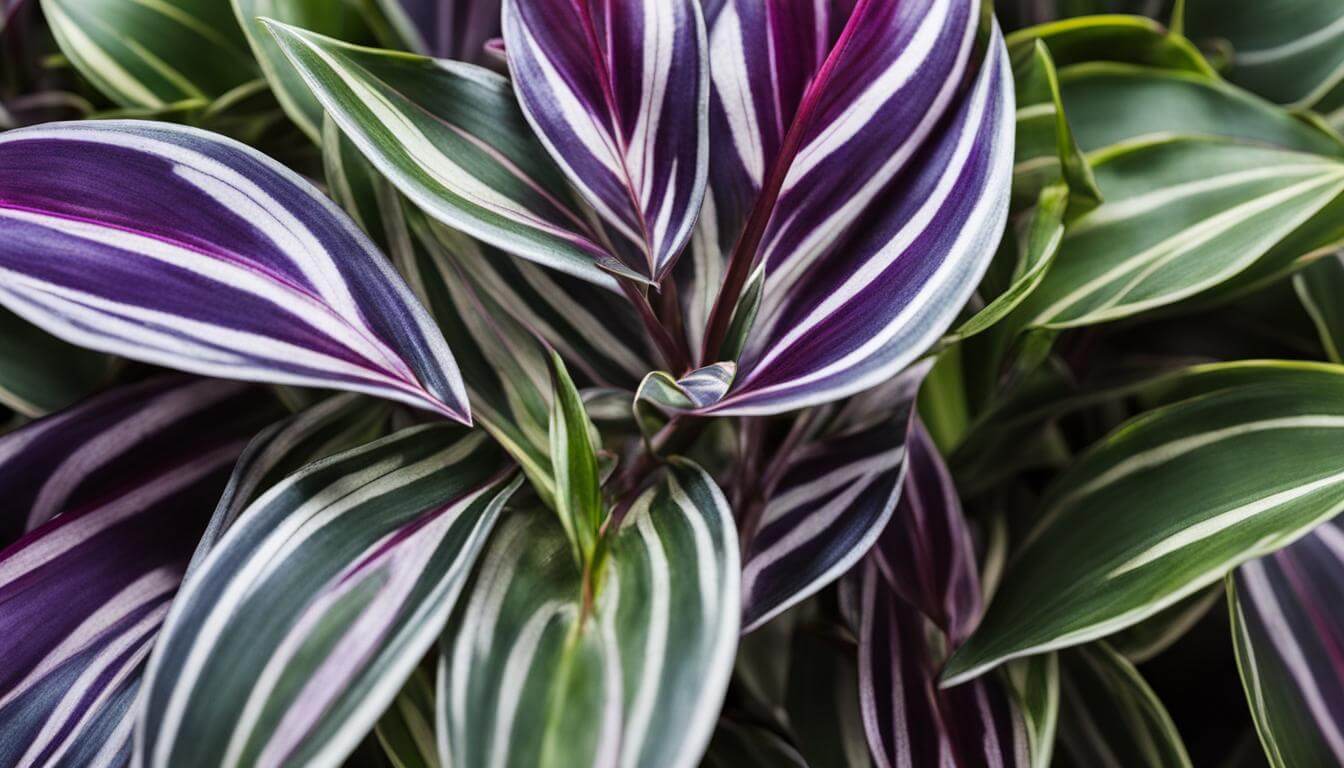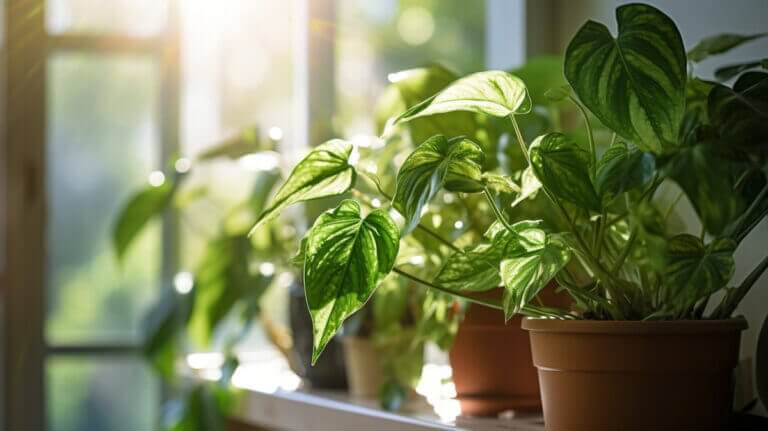Tradescantia zebrina, also known as the wandering jew plant or inch plant, is a popular houseplant known for its variegated foliage. It has succulent stems with ovate to lanceolate leaves that display attractive striped purplish-green coloring. The plant thrives in bright light, but too much direct sun can cause the colors to fade. It can be grown indoors or outdoors in mild climates as a tender perennial. Some popular varieties of tradescantia zebrina include Zebrina pendula (‘Tradescantia pendula’), nanouk (‘Tradescantia albiflora ‘Nanouk’), and various cultivars like ‘Quadricolor’ and ‘Tricolor’. These varieties differ in terms of their leaf colors and patterns. Tradescantia zebrina is easy to grow and propagate, making it a popular choice among plant enthusiasts. It is commonly used as a trailing plant in hanging baskets or as a groundcover. It requires bright light, regular watering, and occasional pruning to maintain its bushy appearance.
Key Takeaways:
- Tradescantia zebrina is a popular houseplant with variegated foliage.
- It thrives in bright light but should be protected from direct sun.
- Popular varieties include Zebrina pendula, nanouk, ‘Quadricolor’, and ‘Tricolor’.
- Tradescantia zebrina is easy to grow and propagate.
- It is commonly used in hanging baskets or as a groundcover.
Growing and Care Tips for Tradescantia Zebrina Varieties
Tradescantia zebrina varieties are relatively easy to grow and care for. They can be propagated through stem cuttings or by placing the plant in water or moist soil. To propagate through cuttings, simply take a stem cutting, remove the lower leaves, and place it in water or moist soil until roots develop. These plants prefer well-draining potting soil and require regular watering to keep the soil evenly moist. However, it’s important to allow the soil to dry out slightly between waterings to prevent overwatering.
Tradescantia zebrina varieties can tolerate a variety of lighting conditions, including full sun to partial shade indoors. They have a trailing growth habit, making them suitable for hanging baskets or trailing over the edges of containers. Pruning is recommended to maintain the plant’s bushy appearance and remove any leggy growth. Tradescantia zebrina varieties can also be repotted as needed, using a well-draining potting mix. They are relatively low maintenance plants and can add a touch of vibrant color to any garden or indoor space.
Tips for Growing and Caring for Tradescantia Zebrina Varieties:
- To propagate, take stem cuttings and place them in water or moist soil until roots develop.
- Use well-draining potting soil for optimal growth.
- Water regularly, allowing the soil to dry out slightly between waterings.
- Provide bright light, but avoid direct sunlight to prevent leaf fading.
- Trim leggy growth to maintain a bushy appearance.
- Repot as needed using a well-draining potting mix.
Overall, tradescantia zebrina varieties are versatile plants that are easy to grow and care for. With their striking foliage and ability to thrive in various conditions, they make a beautiful addition to any garden or indoor space.
| Variety | Leaf Colors and Patterns | Growth Habit | Light Conditions |
|---|---|---|---|
| Zebrina pendula | Striped purplish-green | Trailing | Full sun to partial shade indoors |
| Nanouk | Variegated pink, green, and purple | Trailing | Bright light, avoid direct sunlight |
| Quadricolor | Purple, pink, green, and cream | Trailing | Bright light, avoid direct sunlight |
| Tricolor | Green, pink, and cream | Trailing | Bright light, avoid direct sunlight |
Benefits and Uses of Tradescantia Zebrina Varieties
Tradescantia zebrina varieties offer numerous benefits and can be utilized in various ways, making them a versatile option for both indoor and outdoor spaces. Here are some key advantages and applications of these popular houseplants:
- Ground Cover: Tradescantia zebrina varieties, with their trailing growth habit, can be used as ground covers in gardens or outdoor landscapes. They form a lush carpet of variegated leaves, adding vibrant color and texture to the surroundings.
- Bright Light Tolerance: These plants thrive in bright light conditions, making them suitable for areas with ample sunlight. They can be placed near windows or other well-lit spaces to maximize their growth and variegation.
- Variegated Foliage: One of the main attractions of Tradescantia zebrina varieties is their variegated leaves. The striped purplish-green coloring adds visual interest and can serve as a focal point in any garden or indoor setting.
- Easy to Grow: Tradescantia zebrina varieties are known for their ease of care and propagation. They are relatively low maintenance, making them ideal for both experienced gardeners and beginners looking to add some greenery to their space.
“Tradescantia zebrina varieties offer lush ground cover and thrive in bright light conditions, making them versatile and visually appealing additions to any space.”
These plants are native to Central and South America and can also be found growing in the wild, highlighting their adaptability to various climates and growing conditions. Tradescantia zebrina varieties can be easily propagated through stem cuttings, further adding to their appeal for plant enthusiasts looking to expand their collection. Additionally, certain varieties, such as the purple heart plant (Tradescantia pallida) and spiderwort plant (Tradescantia virginiana), showcase unique colors and delicate flowers, making them attractive additions to garden beds or as standalone potted plants.
Table: Popular Tradescantia Zebrina Varieties and Their Characteristics
| Variety | Leaf Color | Growth Habit | Notable Features |
|---|---|---|---|
| Zebrina pendula | Variegated: purplish-green stripes | Trailing | Classic and popular variety |
| Nanouk | Variegated: green, pink, and purple leaves | Trailing | Eye-catching, multi-colored foliage |
| Quadricolor | Variegated: green, cream, and pink leaves | Trailing | Distinctive color combination |
| Tricolor | Variegated: green, cream, and pink leaves | Upright | Unique variegation pattern |
With their striking variegation and ability to thrive in various light conditions, Tradescantia zebrina varieties are truly versatile plants. Whether used as ground covers, showcased in hanging baskets, or as standalone potted plants, these varieties can enhance the aesthetic appeal of any space. Their easy care and propagation make them an excellent choice for both seasoned gardeners and beginners alike.
Tips for Successful Care of Tradescantia Zebrina Varieties
When it comes to caring for Tradescantia zebrina varieties, it’s important to understand their specific needs. These popular houseplants are known for their vibrant foliage and can thrive in a variety of light conditions. While they prefer bright light, they can also tolerate lower light levels, although this may result in leggy growth and less vibrant colors. It’s worth noting that the undersides of their leaves are a stunning deep magenta color, adding to their visual appeal.
Tradescantia zebrina varieties, such as the tradescantia fluminensis, are part of the Commelinaceae family and have a trailing or spreading growth habit, making them suitable for ground covers or hanging baskets. These plants are relatively easy to grow and propagate, making them a great choice for both indoor and outdoor cultivation. They prefer well-draining soil and regular watering, allowing the soil to slightly dry out between waterings to avoid overwatering and root rot.
While Tradescantia zebrina varieties may produce pink flowers, they are not commonly seen on indoor plants. These plants can vary in leaf color and size, with some varieties displaying deep purple leaves. They are commonly referred to by their common names, including wandering jew plant, inch plant, or spiderwort. To maintain their vibrant foliage and ensure optimal growth, it’s important to provide them with bright indirect light. With their stunning colors and easy care requirements, these varieties are a perfect choice for both indoor and outdoor gardening enthusiasts.
FAQ
What are the different varieties of Tradescantia zebrina?
Some popular varieties of Tradescantia zebrina include Zebrina pendula (‘Tradescantia pendula’), nanouk (‘Tradescantia albiflora ‘Nanouk’), and various cultivars like ‘Quadricolor’ and ‘Tricolor’. These varieties differ in terms of their leaf colors and patterns.
How do I propagate Tradescantia zebrina varieties?
Tradescantia zebrina varieties can be propagated through stem cuttings. Simply take a stem cutting, remove the lower leaves, and place it in water or moist soil until roots develop.
What lighting conditions do Tradescantia zebrina varieties require?
Tradescantia zebrina varieties can tolerate a variety of lighting conditions, including full sun to partial shade indoors. They prefer bright light, but too much direct sun can cause the colors to fade.
How do I care for Tradescantia zebrina varieties?
Tradescantia zebrina varieties require regular watering to keep the soil evenly moist. It’s important to allow the soil to dry out slightly between waterings to prevent overwatering. Pruning is recommended to maintain the plant’s bushy appearance and remove any leggy growth. They can also be repotted as needed using a well-draining potting mix.
What are the benefits and uses of Tradescantia zebrina varieties?
Tradescantia zebrina varieties can be used as ground covers in gardens or outdoor landscapes, providing a lush carpet of vibrant foliage. They are popular houseplants due to their attractive foliage and ability to tolerate a wide range of light conditions. They are easy to grow and care for, making them an ideal choice for beginners.
What are the tips for successful care of Tradescantia zebrina varieties?
Tradescantia zebrina varieties prefer bright light but can also tolerate lower light conditions. They require well-draining soil and regular watering, allowing the soil to dry out slightly between waterings. Providing bright indirect light is key to maintaining their vibrant foliage and ensuring optimal growth.







